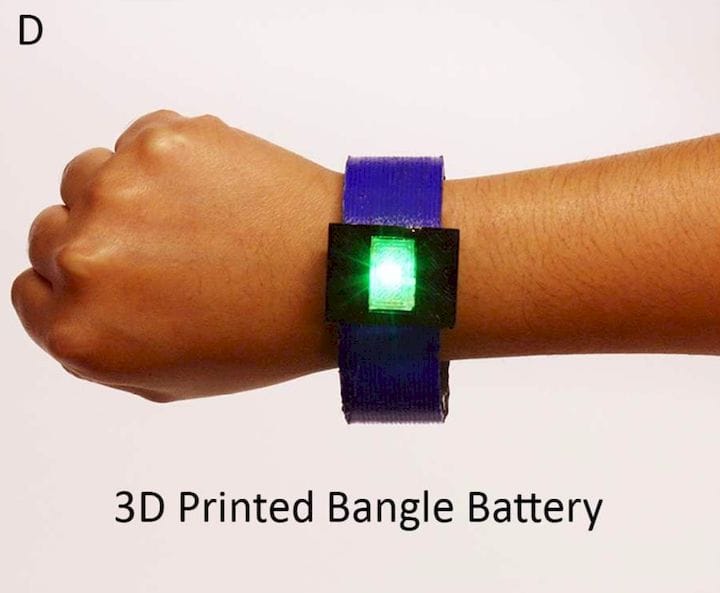![A fully 3D printed bangle - including the battery [Source: ACS]](https://fabbaloo.com/wp-content/uploads/2020/05/image-asset_img_5eb0a2aeeac9f.jpg)
Researchers have been able to 3D print an entire lithium-ion battery, but challenges remain.
The researchers were interested to determine if it were possible to literally 3D print, in a single print job, a fully functional lithium-ion battery. If this is possible, then a new range of 3D printable devices becomes possible.
They intended on using inexpensive filament-based 3D printing processes, and thus focused on developing appropriate filaments to enable this project to succeed.
While there are several conductive 3D printer filaments on the market, these were entirely unsuitable to be made into a battery, as batteries are composed of multiple parts, each requiring different electrical properties:
-
Anode
-
Separator
-
Cathode
-
Electrolyte
-
Collectors
Their approach was to “dope” standard PLA filament with additional materials to alter the electrical properties. This was a kind of search in which they used various substances in different proportions to determine the optimum mix to achieve battery operation, capacity and printability.
In particular they devised a solvent to soak into the anode and cathodes to dramatically increase the material’s ionic capacity.
Similarly, they also used conductive additions to filament material to increase electrical conductivity. They found the best option to be the addition of graphene particles at a maximum proportion of 30%. When they went beyond 30%, they found that the resulting filament was not printable. Other conductivity compounds were found to have even poorer ratios.
![A small battery made from 3D printed components [Source: ACS]](https://fabbaloo.com/wp-content/uploads/2020/05/image-asset_img_5eb0a2af587d7.jpg)
Once they developed the materials, they set about printing the parts to a prototype battery, which they implemented in “coin form”, as seen here.
This prototype actually worked, and they were able to store and pull electrical energy from the device.
![A fully 3D printed battery made in a single job run [Source: ACS]](https://fabbaloo.com/wp-content/uploads/2020/05/image-asset_img_5eb0a2afa2993.jpg)
They then attempted to 3D print a working battery in a single print operation. However, they found that due to the requirement for different materials for each battery component, they had to manually pause the printer to change filament repeatedly through the job. I suspect this would be easier if done with a multi-material 3D printer, which the researchers apparently did not have access to.
Their single-print battery was simple in geometry, a plain rectangle. But it was indeed a working battery!
The researchers found that the battery capacities were extremely low, only around 1% of what might be expected. While they feel that further work could be undertaken to optimize the process and increase capacity, they also felt that the results were essentially too low to be practical for any current purpose.
![A pair of LCD eyeglasses powered by a 3D printed battery [Source: ACS]](https://fabbaloo.com/wp-content/uploads/2020/05/image-asset_img_5eb0a2b009a6f.jpg)
That said, they were able to 3D print a set of LCD sunglasses, where they would dim when a switch triggered the circuit powered by an onboard, printed battery of the type they’ve researched.
Clearly this technology has a long way to go. But if achieved, it could revolutionize how small devices are powered. Currently batteries are made with simple geometric shapes, thus restricting their use within the confined volumes of small devices.
If more geometries are possible, then one could imagine all of the free space within a design being filled with battery material through a complex 3D design.
If you attempted that now, however, you’d simply end up with a complex, larger battery that holds only 1% of the conventional battery.
Via ACS











A research thesis details the incredibly complex world of volumetric 3D printing. We review the highlights.